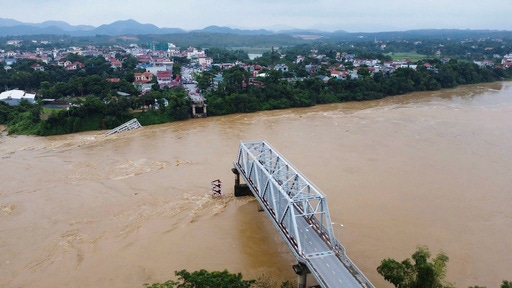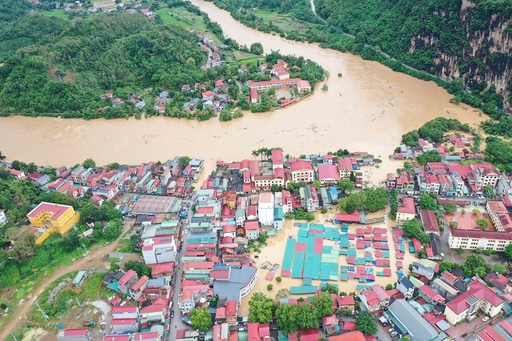Vietnam storm deaths rise to 64 as a bridge collapses and flooding sweeps away a bus

A bridge collapse due to floods triggered by typhoon Yagi in Phu Tho province, Vietnam on Monday, Sept. 9, 2024 (Bui Van Lanh/ VNA via AP)[ASSOCIATED PRESS/Bui Van Lanh]
HANOI, Vietnam (AP) — A bridge collapsed and a bus was swept away by flooding in Vietnam on Monday, raising the death toll in the Southeast Asian country to at least 64 from a typhoon and subsequent heavy rains that also damaged factories in export-focused northern industrial hubs, state media reported.
Nine people died on Saturday after Typhoon Yagi made landfall in Vietnam before weakening into a tropical depression. The rest died in the floods and landslides that followed on Sunday and Monday, state media VN Express reported.
The water levels of several rivers in northern Vietnam were dangerously high.
A bus carrying 20 people was swept into a flooded stream by a landslide in mountainous Cao Bang province on Monday morning. State media said four bodies were recovered from the bus and one person was rescued alive. The others were still missing.
In Phu Tho province, rescue operations were continuing after a steel bridge over the engorged Red River collapsed Monday morning. Reports said 10 cars and trucks along with two motorbikes fell into the river. Some people were pulled out of the river and taken to a hospital, but at least 10 people were still missing.
Nguyen Minh Hai, who fell into the flooded river, told state Vietnam Television, “I was so scared when I fell down. I felt like I’ve just escaped death. I can’t swim and I thought I would die.”
Pham Truong Son, 50, told VN Express that he was driving on the bridge on his motorcycle when he heard a loud noise. Before he knew what was happening, he was falling into the river. “I felt like I was drowning at the bottom of the river,” Son told the news outlet, adding that he managed to swim and hold on to a drifting banana tree to stay afloat before he was rescued.
Dozens of businesses in Haiphong province haven’t resumed production because of extensive damage to their factories, state newspaper Lao Dong reported. It said the roofs of several factories were blown apart and water seeped inside, damaging finished goods and expensive equipment. Some companies said they still didn’t have electricity on Monday and that it would take at least a month to resume production.
Parts of Haiphong and Quang Ninh provinces were still without power on Monday. The two provinces are industrial hubs, housing many factories that export goods, including EV maker VinFast and Apple suppliers Pegatrong and USI. Authorities are still assessing the damage to factories, but initial estimates showed that nearly 100 enterprises were damaged, resulting in millions of dollars in losses, the newspaper reported.
Prime Minister Pham Minh Chinh visited Haiphong city on Sunday and approved a $4.62 million package to help the port city recover.
Typhoon Yagi was the strongest typhoon to hit Vietnam in decades when it made landfall Saturday with winds up to 149 kph (92 mph). It weakened Sunday, but the country’s meteorological agency warned that continuing downpours could cause floods and landslides.
On Sunday, a landslide killed six people including an infant and injured nine others in Sapa town, a popular trekking base known for its terraced rice fields and mountains. Overall, state media reported 21 deaths and at least 299 people injured from the weekend.
Skies were overcast in the capital, Hanoi, with occasional rain Monday morning as workers cleared uprooted trees, fallen billboards and toppled electricity poles. Heavy rain continued in northwestern Vietnam and forecasters said it could exceed 40 centimeters (15 inches) in places.
Yagi also damaged agricultural land.
Before hitting Vietnam, Yagi caused at least 20 deaths in the Philippines last week and four deaths in southern China.
Chinese authorities said infrastructure losses across Hainan island province amounted to $102 million with 57,000 houses collapsed or damaged, power and water outages and roads damaged or impassable due to fallen trees. Yagi made a second landfall in Guangdong, a mainland province neighboring Hainan, on Friday night.
Storms like Typhoon Yagi are “getting stronger due to climate change, primarily because warmer ocean waters provide more energy to fuel the storms, leading to increased wind speeds and heavier rainfall,” said Benjamin Horton, director of the Earth Observatory of Singapore.
___
Associated Press writer Kanis Leung in Hong Kong contributed to this report.
Copyright 2024 The Associated Press. All rights reserved. This material may not be published, broadcast, rewritten or redistributed without permission.
